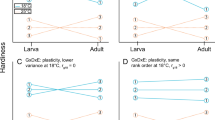Abstract
An increase in genetic variation in body size has often been observed under stress; an increase in dominance variance and interaction variance as well as in additive genetic variance has been reported. The increase in genetic variation must be caused by physiological mechanisms that are specific to adverse environments. A model is proposed to explain the occurrence of an increase in genetic variation in body size in Drosophila at extreme temperatures. The model has parameters specific to the low- and high-temperature regions of the viable range. Additive genetic variation in the boundary temperatures leads to a marked increase in additive genetic variation in development rate and body size at extreme temperatures. Additive genetic variation in the temperature sensitivity in the low- and high-temperature regions adds non-additive genetic variation. Development rate shows patterns in additive genetic variation that differ from the patterns of genetic variation in body size; therefore, the genetic correlation between development rate and body size changes sign repeatedly as a function of temperature. The existence of dominance in the genetic variation in the boundary temperatures or in the low- and high-temperature sensitivities leads to a higher total genetic variance due to higher dominance and interaction variance, for both development rate and body size.
Similar content being viewed by others
References
Barker, J.S.F. & R.A. Krebs, 1995. Genetic variation and plasticity of thorax length and wing length in Drosophila aldrichi and D. buzzatii. J. Evol. Biol. 8: 869-709.
Blows, M.W. & A.A. Hoffmann, 1996. Evidence for an association between nonadditive genetic variation and extreme expression of a trait. Am. Naturalist 148: 576-587.
Blows, M.W. & M.B. Sokolowski, 1995. The expression of additive and nonadditive genetic variation under stress. Genetics 140: 1149-1159.
Bubliy, O.A., V. Loeschcke & A.G. Imasheva, 2001. Genetic variation of morphological traits in Drosophila melanogaster under poor nutrition: isofemale lines and offspring-parent regression. Heredity 86: 363-369.
David, J.R. & M.F. Clavel, 1967. Influence de la température d'élevage sur la mortalité larvo-nymphale et la durée de développement de la Drosophile. Nat. Can. 94: 209-219.
Ferrari, J.A. 1987. Components of genetic variation associated with second and third chromosome gene arrangements in Drosophila melanogaster. Genetics 116: 87-97.
Gibert, P. & G. de Jong, 2001. Temperature dependence of development rate and adult size in Drosophila species: biophysical parameters. J. Evol. Biol. 14: 267-276.
Gilchrist, S. & L. Partridge, 1999. A comparison of the genetic basis of wing size divergence in three parallel body size clines in Drosophila melanogaster. Genetics 153: 1775-1787.
van der Have, T.M. & G. de Jong, 1996. Adult size in ectotherms: temperature effects on growth and differentiation. J. Theo. Biol. 183: 329-340.
Hochachka, P.W. & G.N. Somero, 1984. Biochemical Adaptation. Princeton University Press, Princeton.
Hoffman, A.A. & J. Merilä, 1999. Heritable variation and evolution under favourable and unfavourable conditions. Trends Ecol. Evol. 14: 96-101.
Hoffmann, A.A. & P.A. Parsons, 1991. Evolutionary Genetics and Environmental Stress. Oxford University Press.
Imasheva, A.G., 1999. Environmental stress and genetic variation in animal populations. Russian J. Genet. 35: 343-351.
Imasheva, A.G., D.V. Bosenko & O.A. Bubli, 1999. Variation in morphological traits of Drosophila melanogaster (fruit fly) under nutritional stress. Heredity 82: 187-192.
Imasheva, A.G., V. Loeschcke, L.A. Zhivotovsky & O.E. Lazebny, 1998. Stress temperatures and quantitative variation in Drosophila melanogaster. Heredity 81: 246-253.
de Jong, G., 1990. Quantitative genetics of reaction norms. J. Evol. Biol. 3: 447-468.
de Jong, G. & S. Gavrilets, 2000. Maintenance of genetic variation in phenotypic plasticity: the role of environmental variation. Genet. Res. 76: 295-304.
Karan, D., J.P. Morin, B. Moreteau & J.R. David, 1998. Body size and developmental temperature in Drosophila melanogaster: analysis of body weight reaction norm. J. thermal Biol. 23: 301-309.
Karan, D., J.P. Morin, E. Gravot, B. Moreteau & J.R. David, 1999. Body size reaction norms in Drosophila melanogaster: temporal stability and genetic architecture in a natural population. Genet. Select. Evol. 31: 491-508.
Kojima, K.-I., 1959. Role of epistasis and overdominance in stability of equilibria with selection. Proc. Nat. Acad. Sci. USA 45: 984-989.
Mather, K. & J.L. Jinks, 1971. Biometrical Genetics. 2nd edn, Chapman and Hall.
de Moed, G.H., G. de Jong & W. Scharloo, 1997. Environmental effects on body size variation in Drosophila melanogaster and its cellular basis. Genet. Res. 70: 35-43.
Noach, E.J.K., G. de Jong & W. Scharloo, 1996. Phenotypic plasticity in two populations of Drosophila melanogaster. J. Evol. Biol. 9: 831-844.
Nijhout, H.F. & S.M. Paulsen, 1997. Developmental models and polygenic characters. Am. Naturalist 149: 394-405.
Pál, C., 1998 Plasticity, memory and the adaptive landscape of the genotype. Proc. Royal Soc. London Series B 265: 1319-1323.
Roff, D.A., 2000. Trade-offs between growth and reproduction: an analysis of the quantitative genetic evidence. J. Evol. Biol. 13: 434-445.
Roff, D., 1981. On being the right size. Am. Naturalist 118: 405-422.
Schoolfield, R.M., P.J.H. Sharpe & C.E. Magnuson, 1981. Nonlinear regression of biological temperature-dependent rate models based on absolute reaction-rate theory. J. Theo. Biol. 88: 719-731.
Sharpe, P.J.H. & D.W. DeMichele, 1977, Reaction kinetics of poikilotherm development. J. Theo. Biol. 64: 649-670.
Wagner, T. L., H. Wu, P.J.H. Sharpe, R.M. Schoolfield & R.N. Coulson, 1984. Modeling insect development rates: a literature review and application of a biophysical model. Annals Entomol. Soc. Am. 77: 208-225.
Author information
Authors and Affiliations
Rights and permissions
About this article
Cite this article
de Jong, G., Imasheva, A. Genetic variance in temperature dependent adult size deriving from physiological genetic variation at temperature boundaries. Genetica 110, 195–207 (2000). https://doi.org/10.1023/A:1017974618477
Issue Date:
DOI: https://doi.org/10.1023/A:1017974618477




